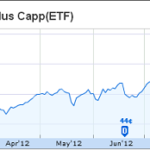While much talk of hot Latin American economies has focused around the Frontier Markets up 22% on the year, Colombia’s ETF (GXG) is up even more on the year, just breaching a 50% gain for the year. This, in a roughly flat to down market for most developed world bourses.
About the Colombia ETF
The Global X/InterBolsa FTSE Colombia 20 ETF is the only broad-based ETF for Colombia. While some ADRs are available on US exchanges like Banco de Colombia (CIB), this ETF incorporates 20 top names and it also carries the ability to invest up to 20% of its assets in derivatives like futures, swaps and options, as well as stocks that aren’t included in the underlying FTSE Colombia 20 Index. The ETF carries an expense ratio of 0.86%. The top holdings are concentrated in Energy and Financial Services with contributions from Consumer Products and Commodities industries.
What’s Driving Colombia Stock Market Performance?
While it’s played out to people familiar with Colombia’s resurgence in recent years, people often associate Colombia with drug trafficking, kidnappings and murders. Unfortunately, this reputation may reside for years, but for the educated investor, that’s just fine – a market mispricing if you will. The country has very much turned around under pro-growth, pro-business leadership.
I have a co-worker who’s actually looking to move there and he’s already speculating in real estate (Gringo slum lord aspirations). He’s traveled there several times recently, done his homework and this is ripe for the picking in his estimation.
Anecdotes aside, the infrastructure’s improving, banks weren’t over-leveraged and burnt by America’s subprime junk like much of Europe, and the trajectory for the economy is up, not flat/declining like most developed nations are looking at in the new normal of austerity from dumb stimulus spending and stagnant growth. Consensus GDP growth for Colombia is pegged at about 5%. Both mining and retail are strong, leading the boom. What’s nice in contrast to other frontier markets is that inflation is rather tame at close to 2%, so consumers aren’t strapped.
The pro-business sentiment growing with Colombia is further evidenced by the landslide victory of the pro-business platform leader Santos in the recent election following Uribe’s end of his 2 terms. His plans include setting up additional free trade alliances with Peru, Chile and others. While the Free Trade Agreement with the US was largely defeated due to protectionism in the US a few years back, it wouldn’t be unreasonable to see this revisited with a more right-leaning Congress post mid-terms if and when it becomes more clear that current policies aren’t working. Surely, Chavez is watching and even Castro made a surprise admission in a recent interview that the Cuba financial model isn’t working.
Key Drivers for Future Price Gains
Primarily, markets hate uncertainty. And with the recent election win and further stability in-country with respect to FARC paramilitary conflicts and economic strength, that uncertainty has been largely resolved. Next, a rising consumer class is driving internal revenues and then exports of gold, iron and other hard commodities lends itself to the similar story we’re seeing in other resource rich countries, which is fast growth and a growing middle class.
Disclosure: Author is long GXG











{ 0 comments… add one now }